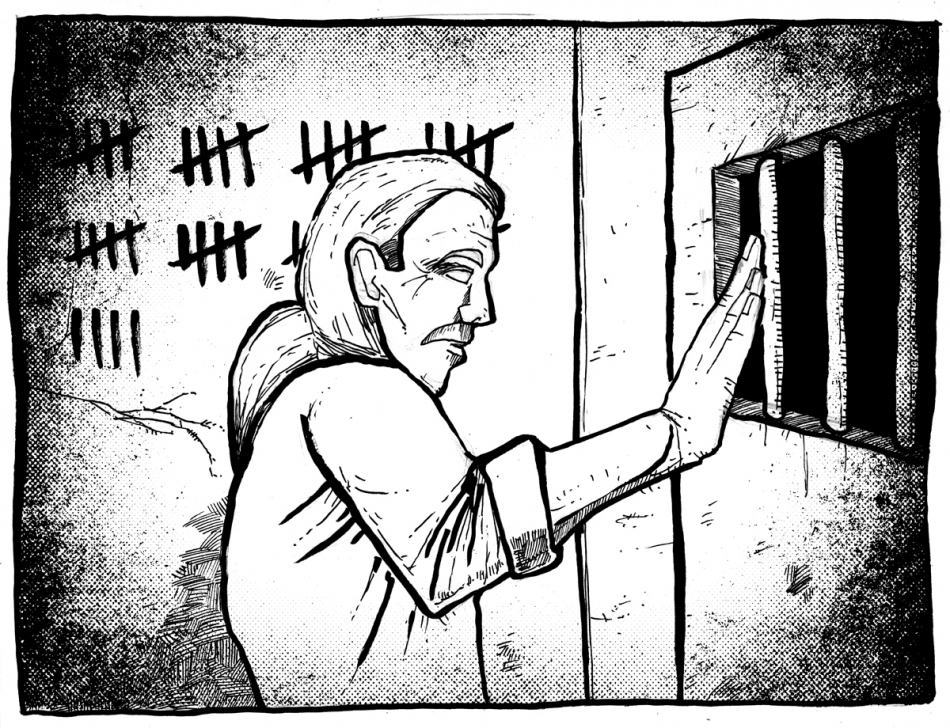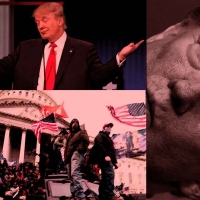Since 1981 political prisoner Mumia Abu-Jamal has sat on death row for a crime which he was wrongly convicted. Almost thirty-eight years later, Abu-Jamal, the former Black Panther is finally getting his day in court as Philadelphia’s city prosecutor dropped his opposition to the appeal. Many thought the political activist was DOA - turns out, even the most hopeless of cases can see a turn of events.
With Abu-Jamal getting his shot at finally tasting real, tangible freedom, is it possible that one of the country’s most high profile political prisoners could also see his appeals pass through the brambles of bureaucratic red tape? For this Native American activist, he and his supporters hope so.
To understand what Peltier has been through, we have to go back to 1976 when Native Americans were “Indians” and getting the snot beat out of you for having braids and brown skin was as common as Archie Bunker winning the hearts of America for being a racist scumbag.
Native blood runs deep in America
Over forty years ago, two unmarked cars rolled onto the Jumping Bull property on the Pine Ridge Reservation, in South Dakota. The car was tailing a beat up red Chevy down dirt roads and past rows of broken down houses. Shirtless, tan men with their long, raven hair watched as the chase whipped past their trailers. The truck was believed similar to one owned by a guy named Jimmy Eagle, who had stolen a pair of high-dollar cowboy boots and gotten into a fistfight with a few good ole’ boys.
Jimmy had apparently landed a few good jabs, because the Feds were on his ass. But, soon the fine leather shit kickers or swapping licks wouldn’t be the story, the shock and awe of gunfire would.
Two FBI agents Ronald Williams and Jack Coler descended on the truck in plain clothes, without offering identification, the occupants of the red truck began to fire. Williams called for backup, pleading with dispatch that if it didn’t arrive soon, they’d be goners. A dark cloud of bullets descended on the two agents.
Whomever was in the truck exchanged gunfire with the Feds while others on the Jumping Bull property joined in the melee with their rifles and pistols. A biblical storm had rolled through the night prior, and now as the agents kneeled for cover in the still-wet long grasses of the plains, all hell broke loose.
It’s still never been exactly established who was driving that red truck. The FBI has their story while witnesses there that day state otherwise.
Hundred of bullets came down from the hills, and Williams next frantic call was to report he and Coler had been shot. Blood and bullets were everywhere. The two Feds weren’t just killed - they were executed. Coler had defensive wounds, meaning he put his hands up to stop the bullets, whomever stood over the FBI agents that morning saw the fear in their eyes and pulled the trigger.
A Native man, Joe Stuntz was dead, but not from random gunfire, from a sniper’s bullet. The FBI maintains the position that Stuntz was in the red truck, despite no factual evidence. No one has ever investigated Stuntz’s death.
The agents lie in bloodstained grass, and the Feds were about to lay the hammer down on the Pine Ridge Reservation, where the Oglala Lakota tribe has called home since 1889.
These men were cops, and when you kill a cop, it’s curtains. The cars were riddled with bullet holes straight out of Warren Beatty’s Bonnie and Clyde.
When the Feds dragged Leonard Peltier with his shaggy black hair and his pre-Jeff Bridges Big Lebowski sweater out of a cabin in Alberta, Canada, they were going to throw the book at this Indian cop killer. The only thing is, Peltier, the man who ran a halfway house for recovering addict Natives wasn’t the executioner that morning in 1976: instead, he became the Fed’s patsy.
It all started with Wounded Knee
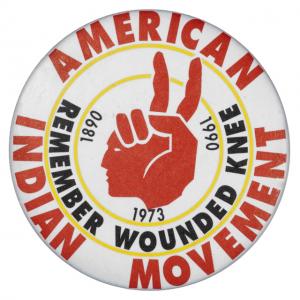 In 1973, 200 Sioux along with members of The American Indian Movement (AIM) occupied the Wounded Knee memorial site in South Dakota, where back in 1890 over 300 Sioux were massacred.
In 1973, 200 Sioux along with members of The American Indian Movement (AIM) occupied the Wounded Knee memorial site in South Dakota, where back in 1890 over 300 Sioux were massacred.
For 71 days battling through pouring rain along with bitter snowstorms the site was shut down to protest Natives being killed and beaten, catching baseball bats to the ribs or a shotgun blast to the back. All thanks to the brutal policies established by Pine Ridge Reservation president, Richard “Dick” Wilson, who was also a Native.
Wilson hated AIM and anyone associated with AIM’s strong adherence to a traditional way of life, stating "the only major Indian problem...bums trying to get their braids and mugs in the press." Despite AIM wanting to help people on the reservation given the mortality rates, suicides, and alcoholism coupled with a staggering number of unemployed Natives at the time.
One of the leaders of AIM, Dennis Banks viewed the occupation as a necessary moment for the tribe in their fight against the violence and torture at the hands of not just Wilson and his crew, but as America as a whole, "As your children want to become doctors and lawyers, they may find it difficult. They may hear 'well, your parents were in a terrorist group. We tell you that now, so you understand it. Tell your children to tell their children this [Wounded Knee] was a very proud moment. Wear that history like a badge of honor. We will never, ever say we were sorry we did it." By the end of the standoff, two dozen Native Americans were injured, twelve more were considered “missing,” and two were pronounced dead.
Wilson got a restraining order to prevent AIM leader Russell Means and AIM for staging any full-scale protests on the Pine Ridge Reservation. AIM had already hijacked cultural spots like the Mayflower and the Bureau of Indian Affairs offices. Wilson’s didn’t want these wild Indians angrying up the already angry blood on the reservation. As political adversaries popped up, Wilson had them snuffed out under the table. Local law has no jurisdiction on Native American reservations.
Over 50 people were savagely murdered for opposing Wilson.
After the Wounded Knee occupation, the Feds had a major punch-drunk crush on the Pine Ridge Reservation where many of the protestors lived. For three years Wilson and his FBI-sanctioned vigilantes, Guardians of Oglala Nation, better known as his “GOONs” had one job: rid the reservation of American Indian Movement activity and keep the locals in step in what was called the “Reign of Terror.”
The GOONs doled out street justice, but because they were on the FBI’s pad, Uncle Sam looked the other way. There was even rumors the FBI supplied the GOONs with armor-piercing bullets.
Death on the reservation
On June 26th, 1975 the reservation was marked for life. What happens here gets murky. There are conflicting reports, bald-faced lies, and plenty of folks who have kept to a code of omerta for far too long.
Peltier, a Lakota AIM leader who was living in Seattle, had set up camp at Pine Ridge, on the Jumping Bull property to help bring peace against Wilson’s GOONs. AIM was asked to be the muscle against a culture of natives turning on natives thanks to the tribal leader nuzzled in the Feds pocket after Wounded Knee.
“Along with many other American Indians who were present that day, I fired shots in the direction of men whom I later learned were federal agents.” Peltier has talked about the shooting at length over the years, but maintains the FBI stormed onto private property, which incited the residents to fight back, “I heard shooting, grabbed my rifle, and ran towards a residence where there were women and children, but quickly ran in another direction because my presence had attracted additional gunfire to the area.”
The Jumping Bull property was chaos. Despite the sun shining and a breeze dancing across the wide plains, three men lie dead in the long grass. As the Natives ran for safety, Peltier jumped into his RV and hightailed it out of town.
The rainstorm blew some of the AIM members tents away the night before, how trivial getting wet seemed now. That morning the women cooked pancakes over an open fire, but the serene moment of reflection was cut short by the sound of gunfire ripping across the air. Peltier and the others grabbed their rifles and pistols out of fear for the women, children and elders all present in the makeshift tent city that was set up.
An Indian on trial
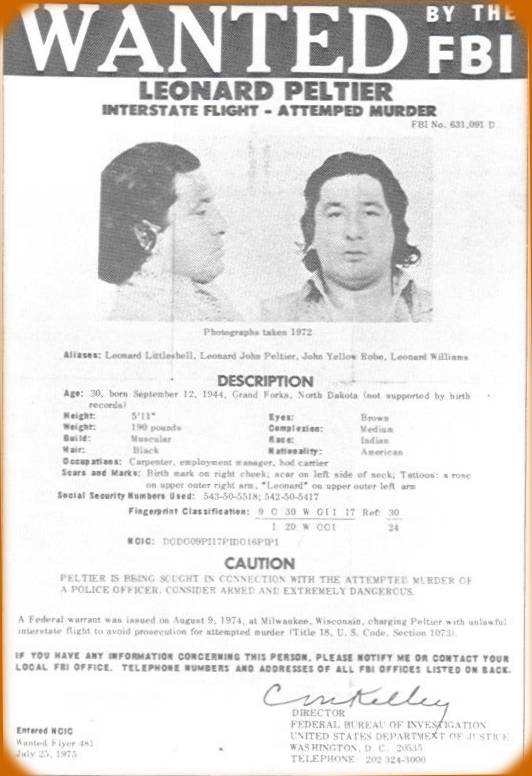 Peltier and two other AIM members Bob Robideau and Darrelle "Dino" Butler were singled out as potential killers, despite over 40 Native Americans shooting upon the agents. Over 100 FBI agents, the GOON squad, local police, as well as Bureau of Indian Affairs officers locked the area down.
Peltier and two other AIM members Bob Robideau and Darrelle "Dino" Butler were singled out as potential killers, despite over 40 Native Americans shooting upon the agents. Over 100 FBI agents, the GOON squad, local police, as well as Bureau of Indian Affairs officers locked the area down.
As the miles between him and the reservation grew, Peltier was scared. After a few phone calls back to the reservation, he had to make a move: he split for Alberta, Canada. Crossing over the border wouldn’t be easy, but it was a chance he had to take.
December 22, 1975, Peltier landed on the FBI Ten Most Wanted list.
Assuming he wouldn’t get a fair trial in the States, Peltier hoped the Canadian government would have his back, but with the power from affidavits given by Myrtle Poor Bear, a local Native American woman claiming she was Peltier's girlfriend, the FBI had Peltier in cuffs without a fight from our Northern neighbors. (Warren Allmand, Canada's Solicitor General, would later admit the documents he was given by the FBI contained false info.)
The FBI agents saw an out with Poor Bear, pulling her into their cars, taking hours long rides, doing their best to pressure her into giving a statement. As the hours and days passed, Poor Bear broke down after seeing autopsy photos of the recently executed AIM leader Anna Mae Aquash whose body was found rotting in a ravine. The agents swore to Poor Bear that word had gotten out that she was an FBI rat and that AIM would have a price on her head.
“They showed me certain parts of her body that were decomposed," Ms. Poor Bear stated, "They said that's how I was going to end up if I didn't cooperate with them. They said they could kill me and get away with it. I was very scared. I got to a point where I believed they would do it.”
"They talked to me real mean. They were threatening me mostly every day. I remember that at one point, they hung the autopsy pictures of Anna Mae up on the hotel room wall. I decided to go ahead with what they wanted me to do."
All Poor Bear wanted was to see her family after days of the FBI torture. Poor Bear claimed she was at the shooting and saw Peltier fire the two shots that sent the agents to their graves. Scribbling her name on a statement prepared by the FBI, she sealed Peltier’s fate. The problem was, Poor Bear didn’t know Peltier. And she was at home folding laundry, miles away from the murders. It was also well known on the reservation that Myrtle Poor Bear was mentally challenged.
Soon after Peltier was extradited from Canada, Poor Bear admitted to lying to the FBI, stating she FBI pressed her hard for a statement they could use to get Peltier in their hands. When the defense brought Poor Bear in as a witness and asked her about her statement, the judge barred her testimony - because of mental incompetence.
Other “witnesses” claimed the FBI had bullied them like they did Poor Bear, the Natives were tied to chairs for hours, denied access to a lawyer, the FBI got the statements they wanted: they coerced these boys, both 17 at the time to say Peltier executed Coler and Williams.
Back in 2000, Myrtle Poor Bear gushed with shame at a Free Peltier event in Toronto, the guilt she felt lie stored in her bones till the day she died. In Fred Kaufman’s Searching for Justice, Poor Bear stated, “They told me they were going to take my child away from me. They told me they were going to get me for conspiracy, and I would face 15 years in prison if I didn't cooperate. They said they had witnesses who placed me at the scene."
As the FBI mounted its case, they weaved together a narrative full of holes, but enough to get the three Native men in the courtroom.
September 5, 1975, Coler’s .308 rifle and handgun and Williams’s handgun were found in a car “in the vicinity” when they pulled Dino Butler out of a house and slapped the cuffs on his tanned wrists.
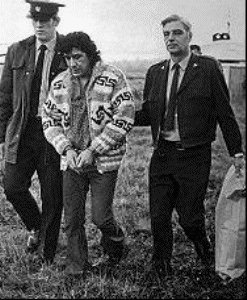 Doing his best to avoid any contact with the law, going through small towns instead of the highways, Peltier’s luck wouldn’t last, he was spotted by an Oregon State Trooper and the officer was going to get Peltier, who at the time was on the Most Wanted list. When Peltier was stopped, he knew it was a life or death scenario. Peltier and the officer exchanged gunfire. Peltier scrambled away on foot after a few bullets nearly took him out. As the Trooper reloaded his weapon, Peltier slipped off into the darkness of the woods. As the RV with Peltier’s supplies sat idling, the Feds were called to the scene. After searching the vehicle, they held Coler’s handgun, offering that they’d found it under the driver’s seat.
Doing his best to avoid any contact with the law, going through small towns instead of the highways, Peltier’s luck wouldn’t last, he was spotted by an Oregon State Trooper and the officer was going to get Peltier, who at the time was on the Most Wanted list. When Peltier was stopped, he knew it was a life or death scenario. Peltier and the officer exchanged gunfire. Peltier scrambled away on foot after a few bullets nearly took him out. As the Trooper reloaded his weapon, Peltier slipped off into the darkness of the woods. As the RV with Peltier’s supplies sat idling, the Feds were called to the scene. After searching the vehicle, they held Coler’s handgun, offering that they’d found it under the driver’s seat.
While driving down the Kansas Turnpike near Wichita, on a brisk September afternoon, Bob Robideau along with two other AIM members were nearly killed when the engine in the station wagon they were seated in exploded. As they sat on the side of the highway, shaken from nearly perishing in the flaming car a few feet in front of them, Federal agents scooped Robideau up, and guess what was found in the charred remains of the vehicle: Agent Coler’s .308 rifle and an AR-15 used at the scene.
In his 1999 memoir Prison Writings, Peltier admitted he fired at the agents, but denies firing the fatal shots with an AR-15. One of the pieces of evidence the Feds used against Peltier was a casing from an AR-15 found in the trunk of Agent Coler's car, the problem was – Peltier didn’t own an AR-15. And out of those 40 shooters, there were many AR-15’s, while Peltier shot his low-powered .303.
In three separate instances the murder weapons seemed to be hidden in plain sight because no one has ever seen a crime flick where the first thing someone does is ditch a weapon linking them to the murder, but here we are.
Because Peltier’s extradition delayed the trial proceedings, both Bob Robideau and Dino Butler’s trials went ahead as planned and both men were acquitted. Because Peltier’s case didn’t happen as fast, the FBI had time to get Peltier under their thumb.
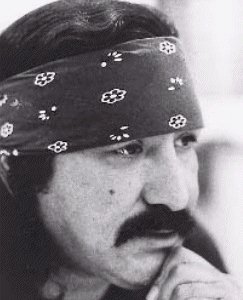 As the FBI stated their claims of murder and mayhem at the hands of these wild Natives, the all white jury in Fargo, North Dakota frothed at the mouth to convict Peltier for killing these innocent, god-fearing lawmen. To stack the deck against Peltier, the Feds made sure to explain in detail to the jury that the agents were executed after they were already mortally wounded. The jury was shown graphic autopsy photos, which were not presented at the trials of Bob Robideau and Dino Butler.
As the FBI stated their claims of murder and mayhem at the hands of these wild Natives, the all white jury in Fargo, North Dakota frothed at the mouth to convict Peltier for killing these innocent, god-fearing lawmen. To stack the deck against Peltier, the Feds made sure to explain in detail to the jury that the agents were executed after they were already mortally wounded. The jury was shown graphic autopsy photos, which were not presented at the trials of Bob Robideau and Dino Butler.
The prosecution kept 140K pages of FBI investigation materials from the defense. Peltier was not allowed to submit a self-defense testimony, which could have led to an acquittal, as Robideau and Butler used as their grounds for returning fire with the FBI agents, thanks to the climate of fear on the Pine Ridge Reservation.
One ballistics expert testified a bullet casing near the agents came from Peltier’s rifle, while a separate test stated Peltier’s gun didn’t match that casing. The two conflicting facts were not presented, only the former.
Despite not being able to place Peltier as the exact shooter, not having a bullet matching his rifle, nor proving he stood as their executioner, the FBI pressed on. In April 1977, Peltier was convicted with two consecutive life sentences.
In the wake of Peltier’s trial, there have been many appeals against the murder conviction. Back in 1986, Federal Appeals Judge Gerald W. Heaney, resolved, "When all is said and done ... a few simple but critical facts remain. The casing introduced into evidence had in fact been extracted from the Wichita AR-15."
***
Finding truth in the blood
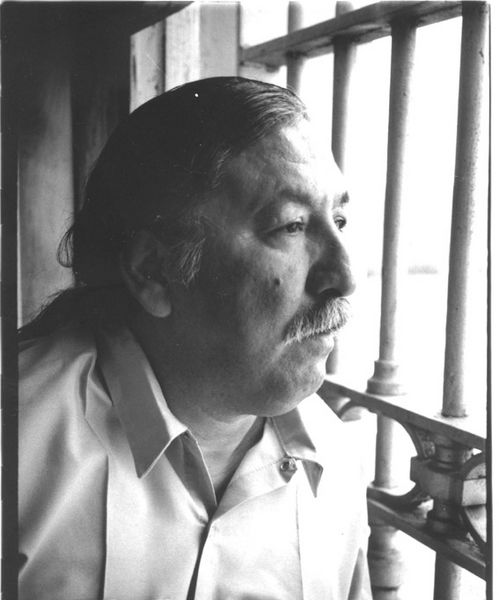 Peltier has become a broken old man. His once long raven hair is now mostly white. While he used to be able to catch a ball or run barefoot through the grass, he’s now victim to a laundry list of ailments, not to mention open heart surgery as well as problems with his jaw. Yet despite his ardent efforts, Peltier can’t get pardoned.
Peltier has become a broken old man. His once long raven hair is now mostly white. While he used to be able to catch a ball or run barefoot through the grass, he’s now victim to a laundry list of ailments, not to mention open heart surgery as well as problems with his jaw. Yet despite his ardent efforts, Peltier can’t get pardoned.
His case has been well-documented over the years with luminaries like The Dalai Lama, Nelson Mandela, Mother Teresa, the Archbishop Desmond Tutu, Mikhail Gorbachev, Kurt Vonnegut, and Robert Redford to cite a very few voicing support.
Redford directed a documentary, The Incident at Oglala which goes deep into Peltier’s case. Darlings of 1990’s MTV, Rage Against The Machine’s first video, “Freedom” wasn’t shredding guitars and exploding mansions surrounded by bikini-clad onlookers. Instead, the band used their three minutes to showcase the injustice Peltier had experienced – Peltier had already spent two decades behind bars.
Because the trial of Leonard Peltier has become a toxic mess of misinformation, people have noticed. The former United States Attorney General Ramsey Clark served for Peltier pro bono and has filed appeals on his behalf, stating the trial against Peltier was "fabricated, circumstantial ... misused, concealed, and perverted."
When Peltier appealed his conviction back in 1992, the charge was illegally changed to aiding and abetting, not murder, which is considered the more “reviewable” appeal thanks to developments with human rights campaigns.
Peltier was denied parole in 2009 because he "participated in the premeditated and cold-blooded execution of those two officers." Meanwhile, the Parole Commission offered it "recognizes that the prosecution has conceded the lack of any direct evidence that [Peltier] personally participated in the executions of the two FBI agents." He won’t be back up for parole till 2024.
Larry Hildes, Peltier’s civil rights lawyer, has been following the case since meeting AIM leader Dennis Banks back in 1986. He saw a friend wearing a “Free Dennis Banks” pin and the conversation led to Peltier. Hildes hasn’t given up hope on Peltier’s case and remains committed to seeing justice finally come full circle.
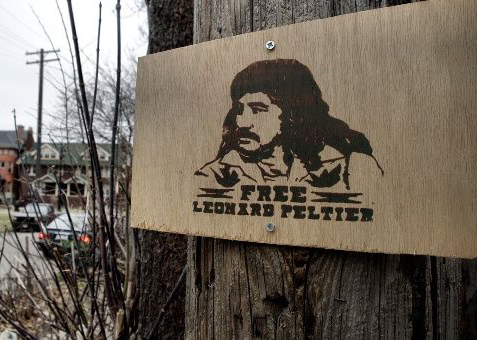 He’s been amazed at how Peltier keeps a stiff upper lip when things seem to go haywire, “Leonard hasn’t lost hope; he never loses hope. He’s always optimistic, even after all of these years. He’s constantly working. It’s incredible to not only work with him but to see that he’s never stopped fighting to tell the truth.”
He’s been amazed at how Peltier keeps a stiff upper lip when things seem to go haywire, “Leonard hasn’t lost hope; he never loses hope. He’s always optimistic, even after all of these years. He’s constantly working. It’s incredible to not only work with him but to see that he’s never stopped fighting to tell the truth.”
Hildes has been working on Peltier’s behalf to get transferred out of Coleman Penitentiary in Florida, given that Peltier isn’t a threat to anyone given his age and health issues. “Coleman is too isolated. The facilities are archaic, at best. Ideally, if he’s going to be stuck in prison, we’d like him to be at Oxford in Wisconsin so his family can visit. South Dakota to Florida isn’t exactly a day trip.”
Still, Peltier’s supporters aren’t giving up. Some of the members of the International Leonard Peltier Defense Committee (ILDPC) have even moved to Tampa to be near him, to offer support. But, while people are still passionate about the case, Peltier does have his down moments according to Hildes, “We’ve been surprised about how many people don’t know Leonard’s story. There’s constantly a struggle to inform people that there are political prisoners. To educate the public – he does feel forgotten.”
***
Peltier isn’t perfect. If anything, he’s a master of bad judgment. When he was locked up at Lompoc back in 79’ Peltier and two other inmates broke free thanks to a security flaw. One of the guys was killed immediately while the other was captured 90 minutes later. Peltier had one goal: make it back into Canada. Peltier once again moved in the shadows, making it only as far as Santa Maria, California. He’d broken into a farmer’s house and managed to steal a Ruger Mini-14 rifle. When the cops found him, he dropped the weapon, but the gun tacked on additional time to his already never-ending sentence: five for the escape and two for the gun.
Back in the Clinton era, there was a lot of talk about granting clemency. Frank Keating, a former Fed and then Oklahoma Governor penned a passionate letter to the Wall Street Journal, saying freeing Peltier would “stain Clinton’s legacy”. To further their position over 500 FBI agents and their families gathered in front of the White House, silently protesting and holding signs saying “Never Forget” with Williams and Coler’s faces on them.
Clinton caved, despite many insiders saying he was a pen stroke away from letting Peltier walk.
Next came George W. Bush and then Obama. Both friendly to the FBI and neither came close to clemency to any prisoner as contested as Peltier, although Obama is an ace lawyer who could’ve hacked apart the case over an afternoon bottle of Miller Lite and a steak burrito.
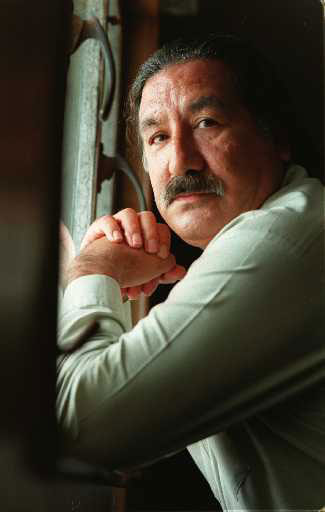 Pope Francis as well as former US Attorney James Reynolds, who happened to supervise the prosecution against Peltier's appeal spoke on behalf of Peltier to Obama, but still nothing. Reynolds even wrote to the Chicago Tribune, stating it "was a very thin case that likely would not be upheld by courts today. It is a gross overstatement to label Peltier a 'cold-blooded murderer' on the basis of the minimal proof that survived the appeals in his case."
Pope Francis as well as former US Attorney James Reynolds, who happened to supervise the prosecution against Peltier's appeal spoke on behalf of Peltier to Obama, but still nothing. Reynolds even wrote to the Chicago Tribune, stating it "was a very thin case that likely would not be upheld by courts today. It is a gross overstatement to label Peltier a 'cold-blooded murderer' on the basis of the minimal proof that survived the appeals in his case."
Over the years, Peltier and his supporters have filed a habeas corpus petition but was rejected. There was a civil rights lawsuit against the FBI in Washington D.C. suggesting they "engaged in a systematic and officially sanctioned campaign of misinformation and disinformation," the case was also immediately dismissed.
There’s plenty of room to make that argument that despite thinking that a sitting president controls the narrative of who walks and who can go free, it’s apparent that the machinations of the police state aren’t a fancy metaphor saved for the movies, but instead this trial proves those puppet master theories true. In order to keep the peace, a President almost has to keep men like Peltier locked up as a token sacrifice to show the office will act in good faith.
Chase Iron Eyes who rose to fame as a vocal member of the Standing Rock tribe has recently become involved in Peltier’s case. Iron Eyes has seen plenty of injustices towards Native people, given the fiasco with the Keystone XL pipeline.
With a long sigh, even Iron Eyes laments that despite Trump being the continual demigod, anti-hero, he could be the perfect person to buck the system and free Peltier, “Trump could be the guy to change Peltier’s life. He exists in a vacuum where laws don’t exist. Whatever came before him, he doesn’t care. We all see how he reacts to situations, to people, and to the FBI. He can change a man’s life. Leonard has paid his debt to society. He’s served 44 years in prison. In speaking with Leonard, he wants to make his next journey from his homeland.”
“People need to understand there’s a new generation of political prisoners coming out of Standing Rock, Peltier's case isn’t an isolated incident, these things are still happening. There’s a pattern being repeated. The Indian wars never really ended. Leonard’s continued political imprisonment is a direct indictment of the toxic relationship between natives and the US. They know they’re wrong.”
Norman Patrick Brown, who was at the scene gave a statement citing that, the FBI, which according to their tapes was said to have been looking for Jimmy Eagle’s red pickup had changed their story to looking for Peltier’s orange and white Chevy Suburban instead. This information was also never considered by the courts.
The case never stops being dramatic, it’s like the world’s most sad rollercoaster because there are rarely any ups, just more downs. In Redford’s Incident at Oglala, Bob Robideau said there was a mysterious “Mr. X” whom the reservation, as well as Peltier, refused to give up, but later admitted as a ploy to shift the attention and blame from Peltier.
In 2002, News from Indian Country's Paul DeMain wrote a piece saying an "unnamed delegation of grandfathers and grandmothers, AIM activists, Pipe carriers and others who have carried a heavy unhealthy burden within them that has taken its toll,” and offered Peltier was behind the killings, but also the death of AIM activist Anna Mae Aquash in December 1975 because she knew dark secrets regarding the case. Peltier had nothing to do with Aquash’s death as he was behind bars and his mail is heavily screened.
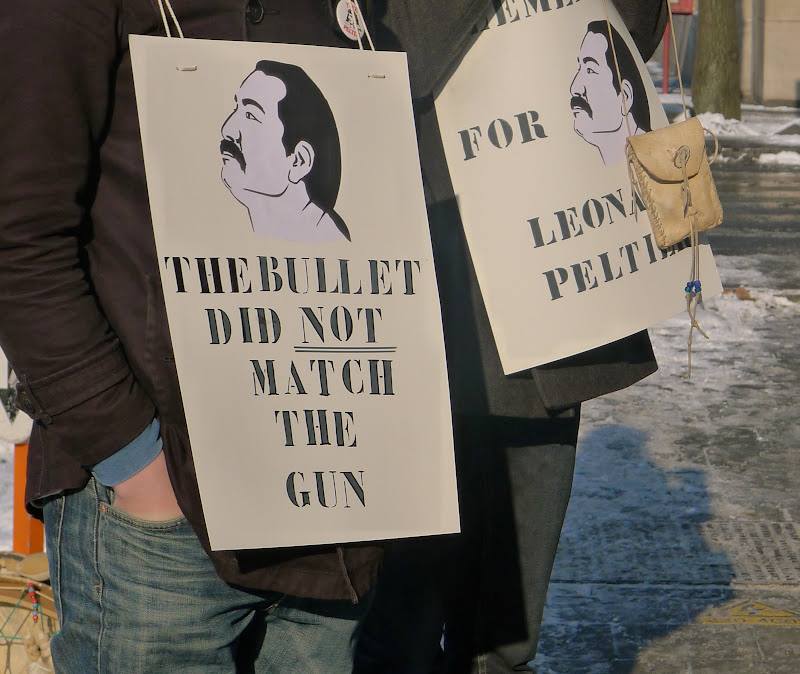 Peltier sued DeMain for libel but soon settled out of court. DeMain issued a statement, stating Peltier didn’t get a fair trial and wasn’t connected to the Aquash murder. While Peltier’s trial is rife with special kinds of crazy, the Aqaush murder trial is a whole circus filled with FBI informants infiltrating AIM, Peltier supposedly putting a gun to Aquash’s head and making her put her fingerprints all over bombs out of fear she was a spy for the Feds.
Peltier sued DeMain for libel but soon settled out of court. DeMain issued a statement, stating Peltier didn’t get a fair trial and wasn’t connected to the Aquash murder. While Peltier’s trial is rife with special kinds of crazy, the Aqaush murder trial is a whole circus filled with FBI informants infiltrating AIM, Peltier supposedly putting a gun to Aquash’s head and making her put her fingerprints all over bombs out of fear she was a spy for the Feds.
Since Peltier’s conviction, he’s been nominated for a Nobel Peace Prize four times, has been a presidential candidate for the “Peace and Freedom Party” and managed to get almost 30K votes.
It’s clear the FBI has a boner for keeping Peltier behind bars. In 2006, U.S. District Judge William Skretny ruled Peltier’s team couldn’t access five of the 800+ internal documents on the case held at the Buffalo field office for "national security and FBI agent/informant protection.” Reviewing the petition only managed to take Skretny 254 days, not because he was stalling or anything.
Skretny, clearly on Team FBI doubled-down, putting his foot on Peltier’s neck further stating, “Plaintiff has not established the existence of bad faith or provided any evidence contradicting (the FBI's) claim that the release of these documents would endanger national security or would impair this country's relationship with a foreign government." Over the years, Peltier’s team of lawyers have asked for over 100,000 of the FBI’s documents and time, and time again, they’re denied access.
If there’s any story left on the bones of this one, it’s there are forces at work behind the scenes. The case is marred with controversy and most of the FBI agents out there now don’t know who Peltier is – he’s a name in a case file marked with a big red X for NO. Someone get a microphone or a tv camera and unearth the case of Leonard Peltier, it’s time we finally came to his aid.
Getting to Peltier is next to impossible. His mail is screened and all communications have to be in an official capacity.
Peltier’s story remains powerful because despite sticking the Native face on a cheap tie-dyed shirt or plenty of white folks claiming Native DNA, America is conditioned to cheapen the history of Native people, coupled along with the constant string of injustices we’ve doled out like shitty Halloween candy. The only way Native Americans make the news is when they’re fighting for water, dead, or locked in cages.
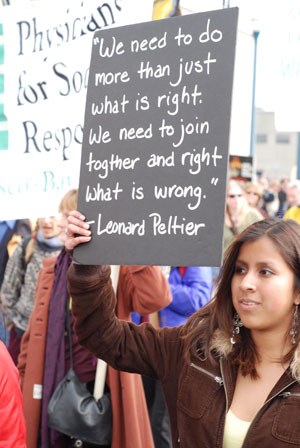 Chase Iron Eyes’ heart is with his people, and with Leonard. Being Native is everything to him, and seeing Peltier suffer through the decades has left a mark; leaving him to wonder when his people, the Native Americans stuck on reservations, sticking casinos on tribal lands will finally get their cultural #MeToo or Black Lives Matter moment. “I just visited Leonard for the first time, and it became obvious the Indian wars are not over. The man was like a myth, something I’ve heard about my whole life, and there he was. But, he was locked up for something he did not do. America is a colonial experiment, but we’re still here – even though we believe in compassion. We’ve always been here along with Leonard.”
Chase Iron Eyes’ heart is with his people, and with Leonard. Being Native is everything to him, and seeing Peltier suffer through the decades has left a mark; leaving him to wonder when his people, the Native Americans stuck on reservations, sticking casinos on tribal lands will finally get their cultural #MeToo or Black Lives Matter moment. “I just visited Leonard for the first time, and it became obvious the Indian wars are not over. The man was like a myth, something I’ve heard about my whole life, and there he was. But, he was locked up for something he did not do. America is a colonial experiment, but we’re still here – even though we believe in compassion. We’ve always been here along with Leonard.”
Speaking about the slain FBI agents, Iron Eyes added, “I wish for healing for Coler and Williams kids. I wish that darkness would be lifted. I wish we could right the wrongs of the past together.”
What happened on the Pine Ridge Reservation is heartbreaking; but people need to know the gruesome details, to see the cars sprayed with bullet holes. Thanks to uncensored content everywhere, people can see the bodies, hear the sounds of tires on a dirt road. But in this story, we don’t want the black boxes stamped over the eyes. A violent history seems appropriate in today’s climate.
*Original Leonard Peltier inspired feature art above by Keith Rosson.

